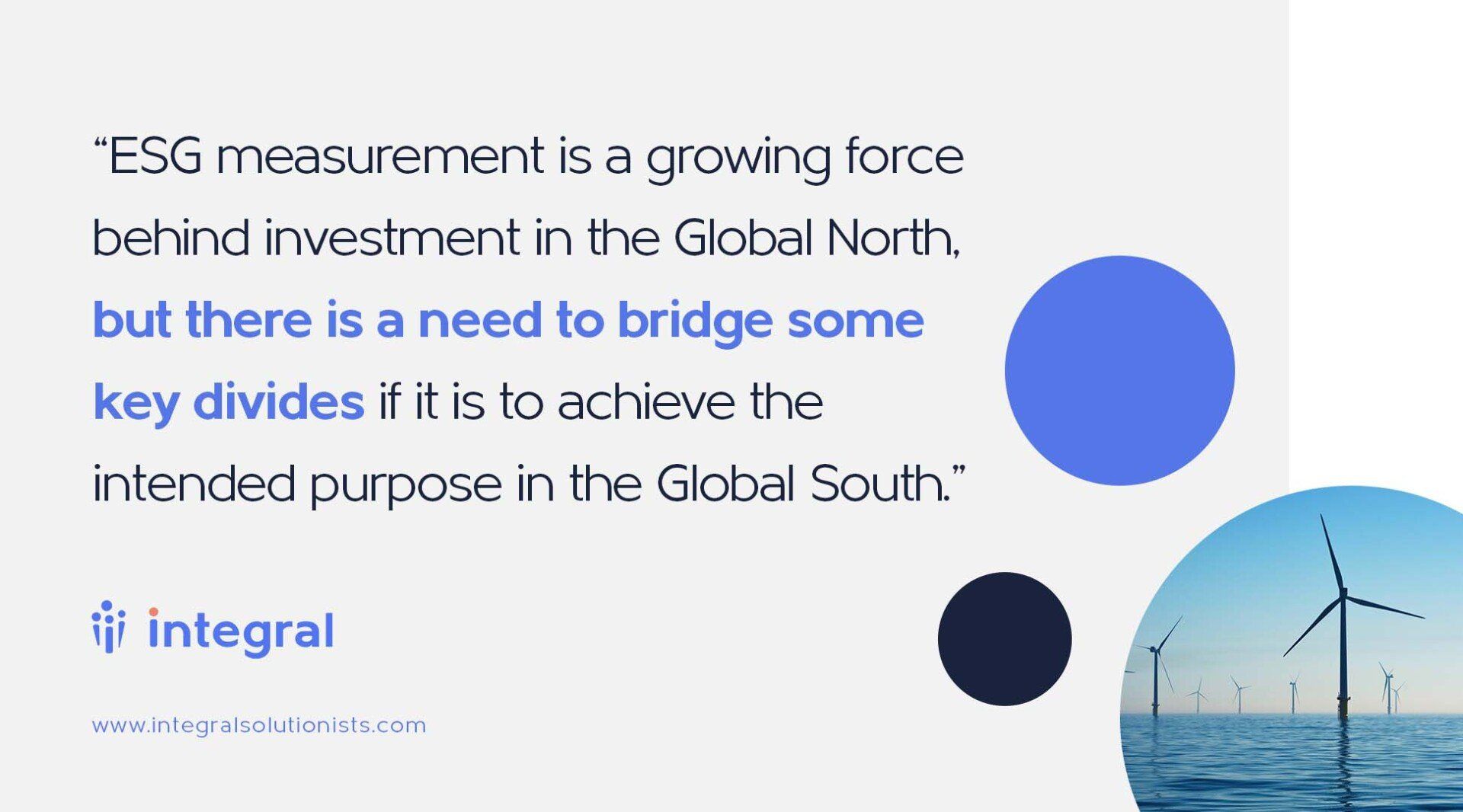Bridging ESG Divides for Climate Resilience
Stay up-to-date on trends shaping the future of governance.
Governance towards Social and Environmental Resilience: Reframing ESG to include perspectives of the Global South
By David Porteous and Jesse Fripp
Environment Social and Governance (ESG) measurement frameworks have proliferated in recent years, both in number and in scope of coverage. Emerging legal frameworks in Europe now seek to address double materiality: not only requiring reporting on how ESG factors may materially affect a company’s performance; but also about how each company affects the societal outcomes in these categories. A process led by the World Economic Forum and International Business Council culminated in the publication of the
WEF/ IBC Report on Measuring Stakeholder Capitalism
in 2020. This report distills longer lists of ESG indicators into a preferred set of 21 core metrics and 34 expanded metrics grouped under four pillars: E,S, G and a fourth called Prosperity (at a societal level). At the recent COP26, the International Financial Reporting Standards Foundation
announced the launch of the International Sustainability Standards Board (ISSB), which will consolidate two previous reporting initiatives and seek to establish harmonized standards. These new sustainability standards will serve as a counterpart to IFRS Accounting Standards which already apply to large public corporations around the world.

We join many others in welcoming this level of focus and attention on ESG related issues. However, we have some concerns about potential unintended consequences which may undermine the achievement of the ultimate purpose of all ESG reporting: after all, all this effort towards disclosure and awareness should lead to more resources addressing the risks and seizing opportunities created by environmental and social issues. Certainly, ESG advocacy by large investors can help to focus management’s attention; but the complexity of some of the emerging frameworks and the speed at which they are evolving risks ESG becoming mainly an issue of costly compliance, best left to managers or professional advisors. In the latest PWC 2021 Annual Corporate Directors Survey of 850 corporate directors, while almost two thirds said that ESG factors were already linked to company strategy, up from just under half the year before, only 25% believed their board had a strong grasp of ESG risks. These gaps between expectations and understanding, and indeed, between investors and boards, open up the risk that the gathering ESG wave crashes on the shores of a compliance only approach. The “G” in ESG is in fact the platform for the achievement of the other two by integrating these wider societal issues in all corporate decision making. In this sense, the governance aspect of ESG is the critical focal point: seen from inside a company, addressing E and S issues is not an addon to governance but is the core of governance itself.
To achieve this outcome, that is to weave ESG factors into the fabric of corporate purpose, we see three divides in particular which need to be bridged.
Bridging North-South divides
In the context of emerging markets, or “Global South” environments, the application of ESG frameworks developed in the North for large public companies is more challenging. Data is less readily available and/or more difficult to verify--the latter is already a challenge even in the North. This is therefore mainly a
divide in resources.
One way to bridge this divide would be to produce a slimmed down set of ESG reporting standards. A lighter set may be a more appropriate starting point for those institutions operating on ‘front lines’ of the effects of climate change in developing countries, rather than at the macro-levels of Global North capital markets and policymakers who are currently driving the ESG agenda. There is precedent for this in the process whereby the International Financial Reporting Standards published The IFRS for SMEs Standards for small and medium non-public entities in 2015 as a way of scaling the full blow set of accounting standards for non-public entities. However, this could only follow the publication of the main standard set, a process which is still a ways off. Another way would be to initiate bottom up processes for the development of appropriate approaches in categories of institutions in the global south, such as microfinance entities and for purpose banks. A process like this would help to ensure that developing countries are not merely takers, but also shapers, of the emerging reporting frameworks. This bridging would ensure better future convergence of reporting sets.
Bridging mitigation and adaptation divides
Current ‘E’ measurement sets, such as the recent WEF-IBG set, focus heavily on climate change mitigation--measuring GHG emissions at different levels of scope, for example. Barely 10% of all climate finance in 2019/20 went towards adaptation according to the Climate Policy Initiative. This is in part because mitigation has received much greater emphasis in industrialized economies, resulting in better resourcing and focus leading to better articulation and definition. By contrast, few indicators seek to measure climate adaptation, yet this is the issue most likely to affect an estimated 4 billion of the world’s most vulnerable who face the reality of direct impacts from the changing environment on their daily livelihoods, and indeed, survival. This reflects a divide in priorities.
Bridging this divide will require much more attention and focus on adaptation and resilience strategies post COP26. There are certainly some useful pointers to follow here. For example, the
Impact Management Project, a collective of investors, funders, and development networks, has demonstrated progress in many areas towards a common set of “S” standards with an increasing view on how these relate to and can inform the “E” of environmental sustainability metrics. In 2020, the CEO of the IMP was seconded to the IFRS to inform and accelerate the recent launch of the ISSB with a series of collaborative framing prototypes for climate and disclosure standards, to provide the new standards board with a ‘running start.’ These include the ‘dynamic and distinctive materiality’ approach captured in their
Statement of Intent to Work Together Towards Comprehensive Corporate Reporting and their
Prototype of a Climate-Related Financial Disclosure Standard - both of which could be further developed and adapted to usefully inform the development of “E” standards that reflect a greater concern with better adaptation and resilience outcomes for vulnerable communities. Another possible benchmark to consider is the
Climate Bonds Initiative, which has developed the
Climate Resilience Principles, designed to ensure that adaptation & resilience criteria and metrics are incorporated into bond issuance and investor assurance related to green bond credentials in a voluntary market.

Not least, the recently launched Digital Finance for Climate Resilience Framework defines an initial roadmap for harnessing the tools of choice and control to enable vulnerable populations to achieve greater adaptation and resilience - and as fintech has been of late the fastest-growing emerging market asset class, affords an opportunity to enhance and indeed, better inform ESG considerations and metrics for the increasing wave of private and public investors entering this space.
Bridging risk-opportunity divides
Is climate change mainly a risk to be managed, or a potential source of new opportunities? It is likely some mixture of both for most organizations, but awareness of risks seems more prominent at present. The board of directors will play a key role in calibrating an organization’s prioritization of its response. This divide is largely inside the organizational mindset and decision making process.
In
Making Sustainability Count, George Serafiem of Harvard Business School argues for a move beyond ‘box ticking’ for ESG compliance to integrating ESG into company decision making as a new source of competitive advantage for companies. There is evidence post COP that funders of all types are starting to think this way, unlocking resources for credible adaptation initiatives.
Banks in the global south are now able to mobilize resources through the issuance of sustainability bonds to finance projects defined as promoting sustainability, whether environmental or social. As one example, Rizal Commercial Bank in the Philippines issued the domestic equivalent of around US$60m in sustainability bonds in March 2021, but
found market demand for the issue to be almost six times higher. In H1 of 2021, multilateral and bilateral development bank’s tripled their green bond issuance over 2020, with Germany’s KfW alone issuing a striking $6.1 billion in certified
Green Bonds, nearly a third of the total, for deployment in a variety of emerging market priority sectors.

Following COP26, members of the coalition of bi-lateral and multi-lateral development and investment banks known as The Adaptation & Resilience Investors Collaborative (or just The Collaborative) issued a broadside of new member and major project commitments, including nearly $35 billion in climate A&R focused investments in the Global South over the next five years, and critical new innovation-accelerating facilities announced by the AFD, CDC UK, FMO, US DFC, and others. Perhaps most telling of all was the announcement by the Glasgow Financial Alliance for Net Zero of the intention to align $130 trillion - or nearly 40% - of global financial assets behind achievement of the climate goals set out in the Paris Agreement. While a laudable and timely statement of intent by nearly 500 leading global financial services firms, it increases the risk of super-charging a top-down ESG approach driven primarily by the mitigation priorities of the Global North, potentially at the expense of the adaptation and resilience crisis increasingly centered on the most vulnerable residents in the Global South.
Conclusion: an investor-led force, ESG should catalyse reinvention of purpose at company level
ESG measurement is clearly here to stay. This should be a positive development for accelerating traction around societal goals. In all the recent activity around ESG, we see some encouraging signs of movement toward greater alignment, but the outcomes from a Global South perspective remain uncertain: divides like the ones we have highlighted here risk fragmenting and even undermining progress. But as we have also highlighted, bridges can be built in ways which will ensure that ESG goes beyond being mainly an investor-led external force to prompt a reinvention of how governance can work for purpose in these days.
AUTHORS

David and Jesse are the founders of Integral and Shining Rock Ventures respectively. They both come from a long background of advisory, management and board roles in for-purpose entities, mainly in the financial sector and in emerging markets. They offer ESG Consulting as well as coaching and mentoring services. Their shared hope and goal is that better governance will result in serving vulnerable societies and people better.
At Integral, we provide ESG Consulting advice, evaluation, facilitation, mentoring and coaching services to develop governance systems that fit your organization’s purpose and stage of growth. To explore further how we can help you,
read about our services, or
set up a free consultation.
S H A R E











